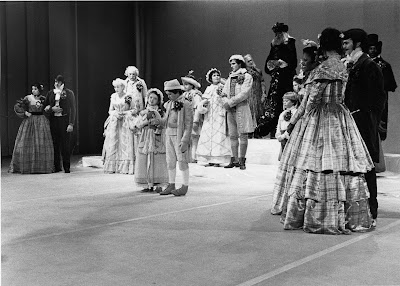The Evolution of a Holiday Classic: A Christmas Carol at A.C.T. Part One
By Michael Paller
In the mid-1970s, regional theaters around the country discovered that audiences wanted a Christmas story at Christmastime, and none more so than Dickens’s A Christmas Carol. Adaptations began appearing, starting with the Guthrie (1974) and the Actors Theater of Louisville (1976). Artistic Director Bill Ball asked Company Director Laird Williamson to look at the handful of existing adaptations and choose one to direct. Williamson found them sentimental and clichéd. They were “sugar-coated Dickens,” he said. “Tiny Tim is not the leading character. Scrooge is the real story.”
Williamson was drawn to the tale’s psychological and social realism, to its “comment on poverty and the inequality of the classes.” He suggested that he and Dennis Powers, the company’s literary jack-of-all-trades, do their own version. Ball agreed. Determined not to produce an animated Christmas card, their version would hew to the story’s dark aspect, its “brutal, painful realities.” “Unless there’s a full articulation of the painful aspects,” Powers said, “the conversion of Scrooge has no meaning.”
Williamson had been impressed with the simplicity and elegance of a Russian adaptation he saw of Gogol’s story “The Overcoat.” The set that he and designer Robert Blackman devised for Carol reflected this approach and provided a metaphor for Scrooge’s move from darkness into light: a tower of safes, money boxes, ledgers, cases, and cupboards, representing the coffins in which Scrooge has buried his feelings. As he regains the feelings that he has locked away, the objects on the tower fall away. All that is left on Christmas morning is a bare framework on which Scrooge can erect a new life based on love and warmth.
For years, the production provided a vehicle for William Paterson and Sydney Walker, who alternated as Scrooge, with occasional appearances in the role by Ken Ruta and Raye Birk. In 1976, Magnin predicted this play would be “another Nutcracker,” and so it was, returning almost every year until 2005, when a new version continued the tradition.
A.C.T.'s production of A Christmas Carol runs through December 24 at The Geary Theater. Click here to purchase tickets through our website.
In the mid-1970s, regional theaters around the country discovered that audiences wanted a Christmas story at Christmastime, and none more so than Dickens’s A Christmas Carol. Adaptations began appearing, starting with the Guthrie (1974) and the Actors Theater of Louisville (1976). Artistic Director Bill Ball asked Company Director Laird Williamson to look at the handful of existing adaptations and choose one to direct. Williamson found them sentimental and clichéd. They were “sugar-coated Dickens,” he said. “Tiny Tim is not the leading character. Scrooge is the real story.”
 |
| The cast of A.C.T.'s 1981 production of A Christmas Carol. |
 |
| Nicholas Perloff-Giles, Andrew Fleischer, Imaide Steverango, and Steven Anthony Jones in A.C.T.'s 2003 production of A Christmas Carol. |
For years, the production provided a vehicle for William Paterson and Sydney Walker, who alternated as Scrooge, with occasional appearances in the role by Ken Ruta and Raye Birk. In 1976, Magnin predicted this play would be “another Nutcracker,” and so it was, returning almost every year until 2005, when a new version continued the tradition.
A.C.T.'s production of A Christmas Carol runs through December 24 at The Geary Theater. Click here to purchase tickets through our website.

